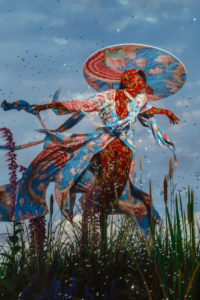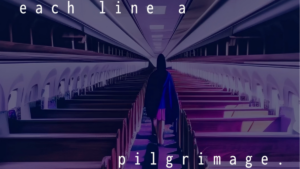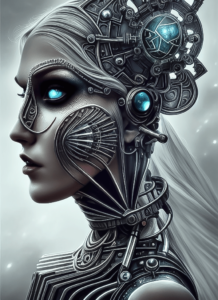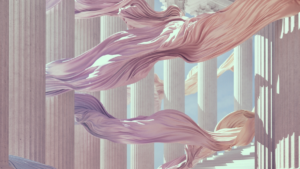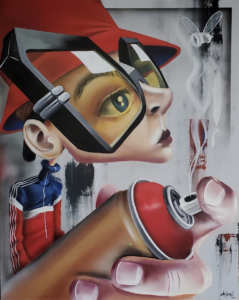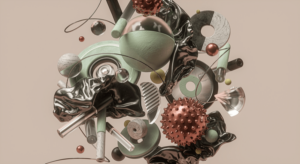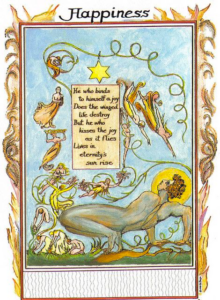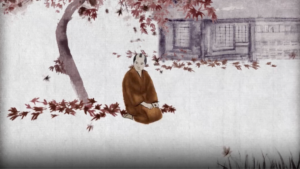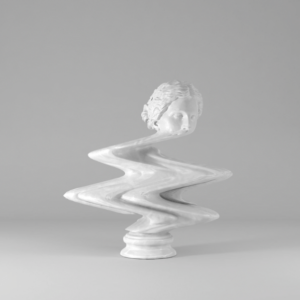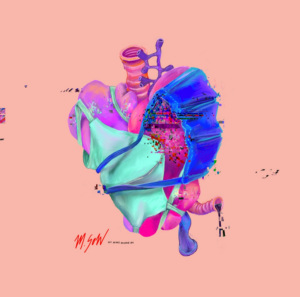“The constant amid all of this changing technology and aesthetics should be a core philosophy or purpose behind your creations.”
— BLAC
BLAC is a multifaceted artist who refers to his post-photographic subgenre as existential surrealism. Having collaborated with AI extensively for the past two years, BLAC’s artistic roots trace back to traditional mediums, including oil painting and photography, which he studied at SCAD and continued to pursue while balancing his multifaceted career as a creative in the tech and advertising industries, where he further refined his skills and technique.
In recent years, BLAC has been at the forefront of exploring the convergence of AI and traditional art forms, emphasizing a core philosophy or purpose behind creations. His artwork often resonates with themes of opposites such as light and dark, chaos and order, and freedom and ruin.
In addition to his artistic endeavors, BLAC has also been instrumental in fostering a community of AI collaborative artists through an incubator aimed at nurturing talent and providing a space for constructive feedback.
Visit BLAC’s MakersPlace Profile
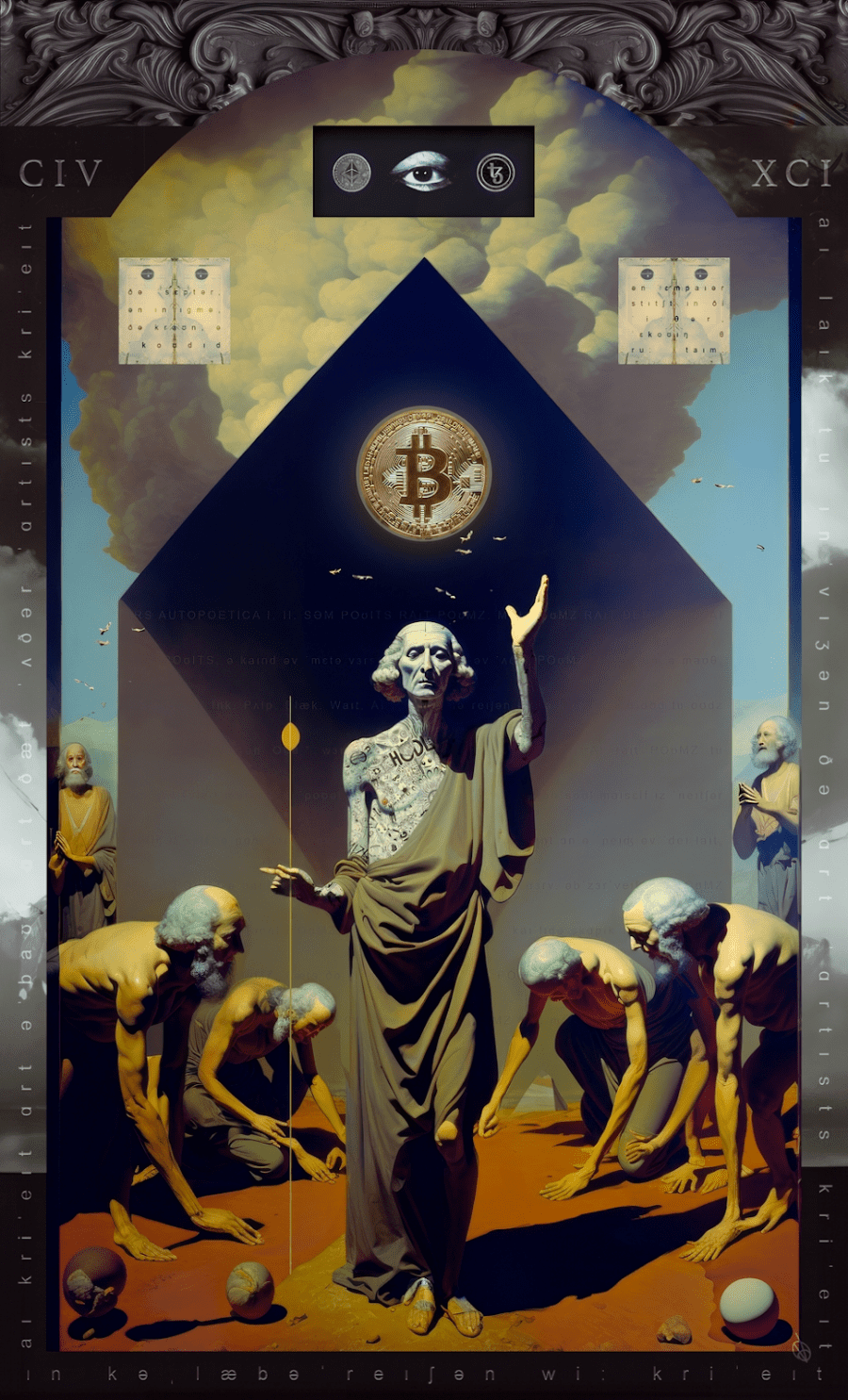
Brady Walker: Can you give a brief introduction for any of our readers unfamiliar with your work?
BLAC: Absolutely, happy to be here. I go by BLAC. I work in what I call existential surrealism and what others refer to as post-photography. I’ve collaborated with AI extensively. I’ve been an artist my whole life, an oil painter and photographer. I’ve been part of numerous creative teams throughout my career. In the last two years, I’ve worked heavily with AI, applying skills I’ve developed over my professional and personal journey with art. It’s been an interesting journey.
BW: I have many questions about your pre-AI life, but I wanted to start with a conversation we had a couple of weeks ago on a Twitter Space. You mentioned that in the age of AI, style is less important than having a core idea or a thematic throughline and a conceptual framework. Can you elaborate on this?
BLAC: Certainly. While style and visual identity are important, traditional artists went through evolutionary periods like a blue period that could last decades. In contrast, artists collaborating with AI can explore and evolve ideas much more rapidly. You can experience a 10-year evolution in perhaps 10 weeks. This fast-paced exploration means you might move beyond a particular style quickly. So, adhering to one visual style, given the tools we have, feels limiting.
The constant amid all of this changing technology and aesthetics should be a core philosophy or purpose behind your creations. It doesn’t have to be singular, but it can be branches of one main idea. We’re in an era with numerous exhibitions and group drops. I’ve seen artists, especially those working with AI, switch their focus swiftly for specific events, creating pieces that don’t align with their broader body of work.
Personally, I aim to establish a core framework or belief system for my work. While everything doesn’t have to fit within this, having a guiding philosophy helps connect all my projects. This approach might be challenging initially, but I believe it simplifies the process in the long run. You become known for an idea rather than a style, which I find more impactful. I hope that offers some clarity.

BW: You mentioned your core ideas focus on opposites like light and dark, good and evil. Did I capture the essence of your philosophy?
BLAC: Yes, I describe it as conceptual contrast. My philosophy is rooted in dark and light, chaos and order, freedom and ruin, good and bad. It’s the nature of the universe. I find solace in creating within this nature, embracing both sides. When viewers experience my work, I aim to invoke thought. Since my early years in art, my goal has been to influence thought, even if it differs from my intent. Conceptual contrasts challenge frameworks of expectation. When viewers see my pieces, I want them to feel something, even if it’s discomfort. Good art can be disruptive. While I respect viewers’ beliefs, I want my art to pose questions. If my work prompts some inner questioning, I consider it successful.
BW: Building on that, I’m curious about sʌbˈstreɪtəm (pronounced “substratum”). This piece showcases the play of opposites with a central figure without eyes, surrounded by contrasting brightness and darkness.
BLAC: That piece was created during my collaboration with NFC Lisbon and MakersPlace. At that time, much of my other work was bright and colorful, hinting at a psychedelic aesthetic. This piece took a different direction. Whenever I sense my work leaning too much toward brightness or enlightenment, I’m compelled to dismantle it. sʌbˈstreɪtəm is about the process of peeling back layers to perceive without truly seeing.
Spiritual growth often requires shedding one’s identity, and we’re often held back by the fear of losing ourselves. This piece conveys that tension—layers of dark and light, reflections of oneself, the absence of eyes juxtaposed with a collaged eye. It’s not about blindness but seeing from a changed self-perspective.
True spiritual enlightenment is accepting this change. The notions of good and bad are societal constructs. To truly understand ourselves, we might need to confront these dualities. This piece, with its layered contrasts, embodies that exploration.
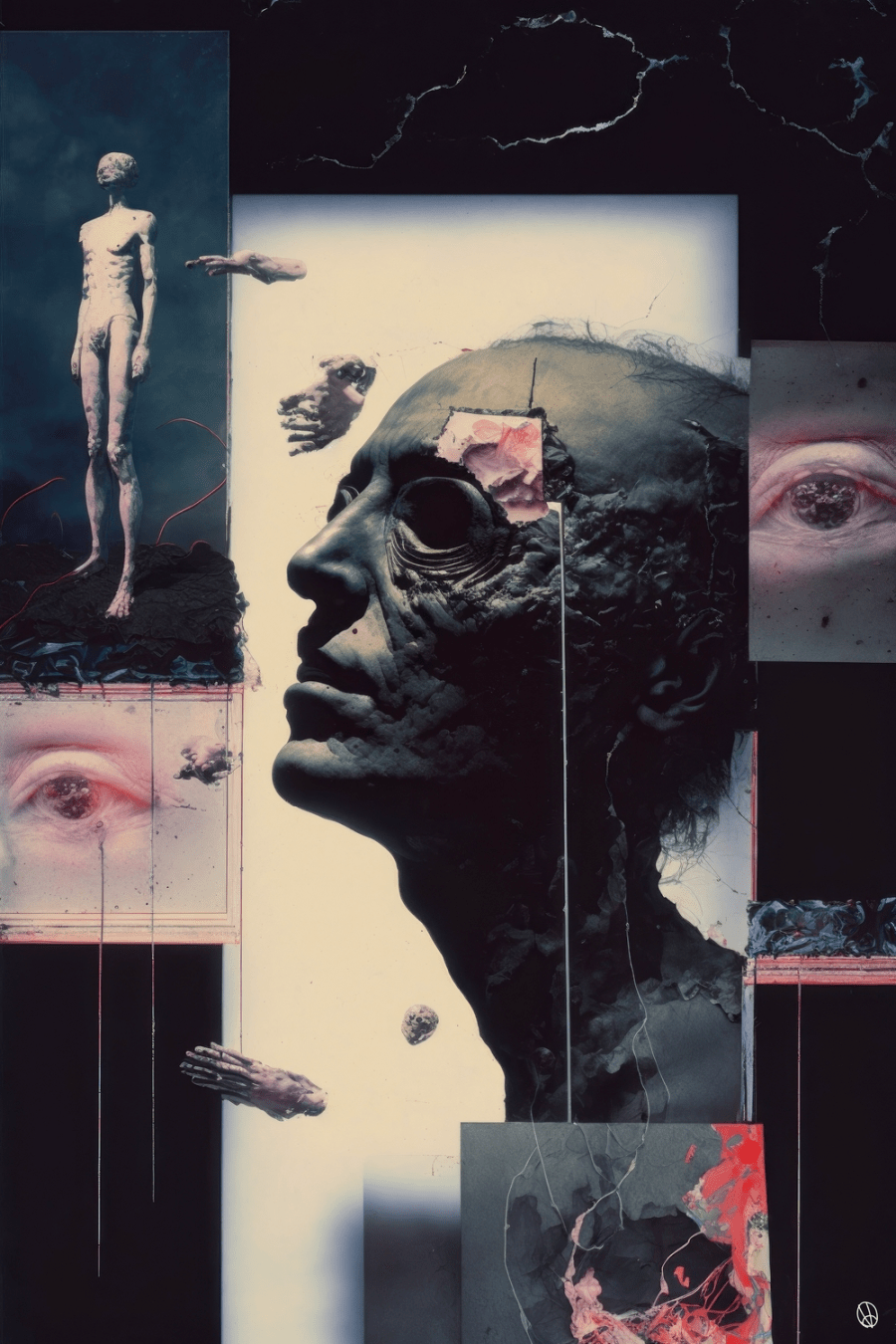
BW: Are you coming to these pieces with a strong spiritual perspective? Can you describe that perspective?
BLAC: I align with the Socratic notion: The wise man knows he knows nothing. I’m aware I truly know very little. Through various spiritual journeys, I’ve had experiences that have questioned our perceived reality. It’s not a boast; it’s an admission of vulnerability. Through meditation, Transcendentalism, Vedic practices, sensory deprivation, astral projection, and psychedelics, I’ve touched on a reality beyond our comprehension.
We’re experiencing a fraction of the vast data and waves of energy around us. Embracing this vast unknown can be humbling and even threatening to our ego. Despite the challenge, surrendering to it can unveil a more valuable truth. Art has been my medium to convey these experiences. Instead of words, my art embodies my beliefs and worldviews.
BW: I think of your piece Aeonic is one such piece that challenges distinctions. There’s a Buddhist sentiment — I’m missing an attribution — but the master tells his pupil, “You’re right in the belief that you’re real but wrong in the belief that you’re really real.” This sense of “yes, but no” is evident in Aeonic. Does your work aim to challenge these false distinctions?
BLAC: Exactly. Everything feels like an illusion, and juxtaposing these illusions next to each other highlights their transient nature. “As before, so ahead” is a nod to “As above, so below” but with a temporal twist. It challenges our linear perception of time. Time feels like an orb, not a line. A sphere with no boundaries, yet we experience it in such a restricted, linear manner. This is the greatest human-created illusion.
My work tries to merge these opposites, like dark and light, or freedom and ruin, to showcase them as a collective entity. Viewers often jump to their ingrained perceptions, but my aim is to center them, to show them the entirety of the road, not just the ditches they’ve become accustomed to.

BW: Earlier today, I spoke with another artist who emphasized that artists should avoid explaining their works, as it limits interpretation. It seems you’re suggesting that our interpretive instincts already lean toward habitual interpretations.
BLAC: It truly depends on the work and the artist’s intentions. I believe a successful artwork aligns with the artist’s intent. If the intent isn’t clear, perhaps it hasn’t been fully realized. As an abstract expressionist painter, my focus was often on the process, using unconventional tools or methods might result in a piece that conveys energy and emotion, but its interpretation is open-ended. Some might see familiar shapes, or it might evoke specific feelings.
Despite the figurative nature of my current work, I approach it with a similar mindset, emphasizing process over rigid control. I aim for viewers to find something within themselves that resonates with the artwork. From both an artistic and market perspective, artworks that resonate deeply with viewers often have more impact. Leaving room for personal interpretation can create a stronger connection between the viewer and the artwork.
On the other hand, some of my series, like the pin number series, are deeply conceptual with extensive narratives. Although I don’t always share these narratives, sometimes I wonder if withholding them does the work a disservice. Explaining the processes and breadcrumbs might benefit other artists seeking a relatable perspective. Yet, for pieces available in the marketplace, I prefer to allow room for personal interpretation, enabling viewers to see a reflection of themselves.

BW: I’ve been eager to discuss Syncretica. Could you provide a broad overview of what the Syncretica ecosystem entails?
BLAC: Certainly. As I mentioned, I wanted to create a framework around my work, and Syncretica emerged from that goal.
Around February or March of this year, I realized, after conversations with several people, that despite the variations in my work—some dark, some light, some abstract—they all existed within the same spectrum. I wanted to define and understand that spectrum.
Using AI tools like LLM Claude and ChatGPT, I started structuring this framework. Initially, I developed an 11-tiered belief system that integrates concepts from alchemy, Vedic traditionalism, Transcendentalism, singularity with technology, and naturalism, among others. Originally, these concepts served as branch points for new series or special projects. But as I dug deeper, I felt compelled to create an entire religious text, both as an art project and perhaps a new belief system, depending on one’s perspective. I’ve recently crossed the 20,000-word mark in its development.
BW: Congratulations on your progress with Syncretica. How do you view it: as an artistic project, a religious spoof, or a sincere articulation?
BLAC: I wouldn’t use the word “spoof.” It’s not a parody or imitation. It’s an exploration at a philosophical and spiritual level. I’ve asked myself just how deep does this go? Given our global experiences in recent years, I’ve never found a religion that fully resonates with me. While I’m not anti-religion, I believe many don’t adequately address all aspects of our reality.
My spiritual and consciousness explorations have largely been due to the lack of a comprehensive belief system. The essence of this project is to answer the question: if I had to adhere to a belief system, what would that be? I’m interested in understanding our reality, from quantum to cosmos, and establishing a framework that embraces both light and dark. Our current belief systems, with narratives that are thousands of years old, often feel unrelatable.
With Syncretica, it’s not about creating a “global religion” for everyone but providing multiple entry points. It’s more flexible. Instead of the all-or-nothing approach many religions take, people can resonate with certain levels or aspects while disregarding others.
I’m building out narratives for each of the 11 layers of Syncretica. The first, Penumbra, involves a traveler navigating behind the Shadow Realm and traversing dimensional frameworks. Interestingly, when I used ChatGPT to establish these frameworks, the AI independently identified “penumbra” as the first level, which felt like validation that I was on the right track.
In essence, the perception of Syncretica—whether embraced by many, few, or just me—isn’t my primary concern. The journey and process matter more than the outcome.

BW: Can you elaborate on the full-scale narrative alluded to in the map regarding Penumbra?
BLAC: Sure. Within Syncretica, there are 11 layers, each with its own characters, art, and narrative. The first one I’m focusing on is Penumbra. I have 24 chapters planned, and this narrative will comprise about 60% of what’s represented within the Penumbra layer. Another 30% will be a reflection or interpretation, analyzing themes like the sacrifice of identity, ego vulnerability, and transformation toward enlightenment. The remaining 10% will focus on actionable tasks or personal actions to help individuals explore these themes.
Each layer follows a similar structure but with varying focal points and purposes. Initially, my target was roughly 111,000 words, aiming to be the second-largest religious text after the Bible, which contains about 750,000 to 780,000 words. But, based on my recent progress, I project around 48,000 to 50,000 words for the narrative of each layer. Considering all components, each layer might total about 88,000 words. With 11 layers, this would amount to 880,000 words, potentially making it the largest religious text in the world.
BW: I imagine that you have a long timeline ahead of you. I assume you plan for this to take a significant amount of time.
BLAC: I expect it to be a lengthy endeavor, though I’m not entirely sure how to map it out. But, my processes, especially incorporating AI, are helping to make this ambitious project more manageable. Without AI, I think accomplishing this solo would be nearly impossible. I’ve been using ChatGPT and my custom Claude 100k model to shape the narratives.
Then, I transfer that work to a program called Sudo Write, using their storyboard feature to weave everything together. While I’ve surpassed 20,000 words so far, that’s been with about 10 hours of actual writing. The preparatory work took much longer.
One challenge I foresee is integrating my fine art with the narrative. For the pieces I’ve already created for Penumbra, I know their nuanced symbolism. But for future pieces, without a pre-written story, these specific details might be lacking. I wonder if I’ll create a visual component for each layer. I don’t want to be overly prescriptive; I’d rather let it evolve organically. If I remain adaptive, I believe I could potentially complete this within a year, barring external disruptions.

BW: The full thing?
BLAC: I’ll be done with the Penumbra story probably in the next week.
BW: Wowzers!
BLAC: I’m on a roll with it right now. I know the direction it’s taking. With the actual art, the last Penumbra piece took me about 50 hours. Some people might assume AI artists just produce and release quickly, and while some do, many of us use compositing techniques. We fine-tune to get exactly what we want, sometimes virtually painting from different starting points. There’s no way I can produce detailed visuals for every story, for every chapter. That might take more than a lifetime. So I’ll have to find shortcuts or pull from different sources. I don’t want to impose too many rigid rules on myself.
BW: Do you have any plans for releasing the text widely?
BLAC: I’m unsure. I’ve considered it, but it’s going to be a substantial book, not inexpensive to produce. I’m debating the best medium for it. Another concept I’m exploring is creating custom LM models for every main character or entity within each layer, allowing people to interact with them, essentially custom chatbots constructed from the layers. Given the short attention spans these days, presenting 900,000 words is a tall order. But for me, it’s more about the experience. There will definitely be a physical form, and I’m also considering an encrypted version. I’ve been writing a lot using encryption, especially with the Penumbra pieces. So, I foresee breadcrumbs and encrypted easter eggs embedded throughout. A digital version is a certainty, and I’m contemplating an audio version—perhaps having AI read it.

BW: That’d be a lengthy audiobook. Why not use AI for your voice?
BLAC: Exactly. Today’s technology allows us to do so much in less time. It’s both a boon and a challenge, but I believe it’s feasible.
BW: You ventured into the web3 art world with your AI collaborative work in 2022 and graduated from art school in 2007. Can you shed some light on the years between art school and 2022? How did you express your creativity during that period?
BLAC: As an artist, much of my work was deeply personal. I painted a lot but never tried to sell anything. I’d gift my paintings for occasions like birthdays or weddings. Professionally, I cycled through various roles in ad agencies, managed a few businesses, and collaborated with startups as a consultant and advisor.
I wore many hats: Art Director, Creative Director, Marketing Director, and Photography Director, to name a few. My experiences ranged from shooting live events and product photography to branding and revenue generation strategies. Over time, I honed skills in photo shoots, self-curation, post-editing, and graphic design. These skills, combined with my technical knowledge and personal expression, converged in this new phase of my artistic journey.
BW: Can you tell me about the artists incubator you run?
BLAC: I started it around February or March. Initially, it was a space for artists to share works in progress and receive constructive feedback. I provided a guide on critique, helping artists understand how to ask for valuable input. We have over 300 members now, and the atmosphere is relaxed.
Every Friday, we host a live feedback session. It started as a stream but has evolved into live video calls where we discuss each other’s work and offer insights. Occasionally, we’ll focus on specific topics like world-building. The main rule is no self-promotion.
The incubator remains largely under the radar, but it’s open to anyone interested in genuine participation. For me, the most rewarding aspect is witnessing the rapid progress and evolution of the artists. It’s astonishing to see two years’ worth of growth condensed into a few weeks. Some of the work being created is genuinely groundbreaking, and it’s a privilege to be part of that journey.

BW: Are these primarily AI collaborative artists?
BLAC: Predominantly, yes. Not intentionally, but that seems to be the community surrounding me. What’s intriguing is when new members share their backgrounds. Many have extensive experience in the creative fields beyond AI. There’s a misconception that someone new to AI art might be inexperienced overall, but many have decades of creative expertise. They’re simply using a new tool.
BW: If you could go back to 2007 when you were graduating from art school and impart a piece of wisdom regarding creativity, the creative process, or building a creative career, what would you tell yourself?
BLAC: I’d advise myself to pursue my passion for art more earnestly. While I’ve always been passionate, it remained a side interest as I focused on my professional career. Now, the fulfillment I derive from art is unparalleled to anything I’ve felt professionally. But, this path has its challenges and risks. Generally, I don’t dwell on regrets because each choice led me to where I am, and I’m grateful for my journey.

BW: My recurring question lately has been: What is art for? Why do humans create and appreciate art? Is it merely another form of communication or is there more depth to it?
BLAC: Art allows people to convey complex ideas in a straightforward manner. It’s the essence of the saying “a picture’s worth a thousand words.” You can encapsulate a multifaceted emotion, story, or concept into a single image, which is a remarkable ability.
In my view, art might be humanity’s genuine superpower. We can craft something from nothing and make it resonate with individuals who don’t even know us. That’s profound. It’s fundamentally a tool for manifesting inner expressions. Whether the outcome is provocative, disruptive, meaningful, or seemingly empty, its impact lies in the perception of the observer, not solely in its creation.
I see the role of an artist as dual-faceted: first, the act of expression, and second, the experience it evokes in others. The two are interconnected; art requires an observer to bring full meaning to it. How they interpret the art is up to them. Art that touches on social or political issues can be extremely influential with just one image. Whether it’s potent cultural symbols or even propaganda, art can mold, instruct, and even manipulate. Its power, good or bad, depends on the creator and those who disseminate it. Essentially, art captures intricate thoughts in a way that’s more profound than mere pixels on a screen or waveforms in a musical track.
BW: I appreciate that answer. Lately, I’ve been pondering the power of storytelling. While it’s often a force for good, there’s a subtle yet profound influence it can exert, neither strictly good nor bad. But being able to craft a compelling narrative and having people believe it grants significant influence. Like you said, it’s a superpower.
BLAC: Absolutely. Throughout history, we’ve seen storytelling impact societies, sometimes for the better and other times not. People often look to stories to find themselves or seek guidance, and a resonating voice can spur positive change. But the inverse is equally possible. That duality, in essence, epitomizes what art represents: its potential to embody both spectrums.
For updates on all of our upcoming editorial features and artist interviews, subscribe to our newsletter below.
- SEO Powered Content & PR Distribution. Get Amplified Today.
- PlatoData.Network Vertical Generative Ai. Empower Yourself. Access Here.
- PlatoAiStream. Web3 Intelligence. Knowledge Amplified. Access Here.
- PlatoESG. Carbon, CleanTech, Energy, Environment, Solar, Waste Management. Access Here.
- PlatoHealth. Biotech and Clinical Trials Intelligence. Access Here.
- Source: https://rare.makersplace.com/2023/10/12/dissolving-binaries-creating-religions-and-building-community-interview-with-blac/?utm_source=rss&utm_medium=rss&utm_campaign=dissolving-binaries-creating-religions-and-building-community-interview-with-blac
- :has
- :is
- :not
- :where
- $UP
- 000
- 1
- 10
- 100k
- 11
- 20
- 2022
- 24
- 300
- 50
- 9
- 970
- a
- ability
- Able
- About
- above
- absolutely
- ABSTRACT
- accepting
- accomplishing
- Act
- actions
- actual
- Ad
- adaptive
- addition
- address
- adequately
- adhere
- adhering
- Advertising
- advise
- advisor
- After
- age
- agencies
- ago
- ahead
- AI
- ai art
- aim
- aimed
- Aiming
- Alchemy
- align
- Aligns
- All
- allow
- Allowing
- allows
- already
- also
- Although
- always
- am
- ambitious
- Amid
- among
- amount
- an
- analyzing
- and
- Another
- answer
- any
- anyone
- anything
- Applying
- appreciate
- approach
- ARE
- around
- Art
- artist
- artistic
- Artists
- artwork
- artworks
- AS
- ask
- aspect
- aspects
- assume
- At
- Atmosphere
- attention
- audio
- available
- avoid
- aware
- back
- backgrounds
- Bad
- balancing
- based
- BE
- because
- become
- been
- before
- behind
- being
- belief
- beliefs
- believe
- below
- benefit
- BEST
- Better
- between
- Beyond
- Blindness
- blockchain
- Blue
- body
- book
- both
- Both Sides
- boundaries
- Branch
- branches
- branding
- Breadcrumbs
- Bright
- bring
- broad
- broader
- Building
- businesses
- but
- by
- call
- called
- Calls
- CAN
- capture
- captures
- Career
- Center
- central
- certain
- certainly
- certainty
- challenge
- challenges
- challenging
- change
- changed
- changing
- Chaos
- Chapter
- chapters
- character
- characters
- chatbots
- ChatGPT
- choice
- clarity
- clear
- collaborated
- collaborating
- collaboration
- collaborative
- Collective
- colorful
- combined
- coming
- Communication
- community
- compelled
- compelling
- complete
- complex
- component
- components
- comprehensive
- concept
- concepts
- conceptual
- Concern
- Connect
- connection
- Consciousness
- Consider
- considered
- considering
- constant
- constructive
- consultant
- contains
- continued
- contrast
- contrasts
- control
- Convergence
- Conversation
- conversations
- Core
- Cosmos
- could
- Couple
- craft
- create
- created
- Creating
- creation
- creations
- Creative
- creativity
- creator
- Crossed
- cultural
- curious
- Current
- custom
- Dark
- data
- Days
- debating
- decades
- deep
- deeper
- define
- definitely
- Depending
- depends
- depth
- describe
- Design
- Despite
- detailed
- details
- developed
- Development
- DID
- different
- digital
- direction
- Director
- discuss
- disregarding
- disruptions
- disruptive
- Ditches
- do
- does
- Doesn’t
- done
- Dont
- Drops
- due
- during
- each
- eager
- Earlier
- Early
- ecosystem
- Editorial
- Eggs
- Elaborate
- embedded
- embodies
- embraced
- Embraces
- embracing
- emerged
- emotion
- emphasized
- emphasizing
- empty
- enabling
- encrypted
- encryption
- endeavor
- endeavors
- energy
- Entire
- entirely
- entirety
- entity
- entry
- equally
- Era
- especially
- essence
- essentially
- establish
- establishing
- Even
- events
- Every
- everyone
- everything
- evident
- evolution
- evolve
- evolved
- exactly
- Exhibitions
- existential
- expect
- expectation
- experience
- Experiences
- experiencing
- expertise
- explaining
- exploration
- explore
- Exploring
- express
- expression
- expressions
- extensive
- Extensive Experience
- extensively
- external
- extremely
- eye
- Eyes
- false
- familiar
- far
- fast-paced
- fear
- feasible
- Feature
- Features
- February
- feedback
- feel
- feelings
- felt
- few
- Fields
- Figure
- Find
- fine
- Fine Art
- First
- fit
- flexible
- focal
- Focus
- focused
- focusing
- follows
- For
- Force
- forefront
- foresee
- form
- forms
- fostering
- found
- fraction
- Framework
- frameworks
- Freedom
- Friday
- from
- fulfillment
- full
- full-scale
- fully
- fundamentally
- further
- future
- generally
- generation
- genuine
- get
- gift
- Give
- given
- Global
- Go
- goal
- going
- good
- grants
- graphic
- grateful
- greatest
- groundbreaking
- Group
- Growth
- guidance
- guide
- had
- hand
- happy
- Have
- having
- he
- heavily
- Held
- help
- helping
- helps
- here
- highlights
- his
- history
- hope
- host
- HOURS
- How
- How To
- HTTPS
- Humans
- i
- I’LL
- idea
- ideas
- identified
- Identity
- if
- Illusion
- image
- imagine
- Impact
- impactful
- important
- impose
- impossible
- in
- Including
- incorporating
- incubator
- independently
- individuals
- industries
- inexpensive
- influence
- Influential
- initially
- input
- insights
- instead
- instrumental
- Integrates
- Integrating
- intent
- intentionally
- intentions
- interact
- interconnected
- interest
- interested
- interesting
- interpretation
- Interview
- Interviews
- into
- intricate
- intriguing
- Introduction
- involves
- issues
- IT
- ITS
- jones
- journey
- Journeys
- jump
- just
- just one
- Know
- knowledge
- known
- knows
- Lack
- lacking
- largely
- largest
- Last
- layer
- layered
- layers
- leaving
- Led
- less
- let
- Level
- levels
- lies
- Life
- lifetime
- light
- like
- limits
- Line
- Lisbon
- little
- live
- Live Events
- Long
- longer
- Look
- losing
- Lot
- mailchimp
- Main
- make
- Making
- man
- managed
- manner
- many
- map
- March
- mark
- Market
- Marketing
- Marketing Director
- marketplace
- master
- Matter
- max-width
- me
- meaning
- meaningful
- means
- Meditation
- medium
- Members
- mentioned
- mere
- merely
- Merge
- methods
- might
- Mindset
- misconception
- missing
- model
- models
- more
- most
- move
- much
- multifaceted
- multiple
- musical
- my
- myself
- name
- NARRATIVE
- narratives
- Nature
- navigating
- nearly
- Need
- Neither
- never
- New
- Newsletter
- next
- next week
- NFC
- no
- nor
- nothing
- Notion
- now
- number
- numerous
- nurturing
- occasions
- of
- offer
- Offers
- often
- Oil
- Old
- on
- ONE
- open
- or
- order
- organically
- originally
- Other
- Others
- our
- ourselves
- out
- Outcome
- over
- overall
- overly
- overview
- own
- painter
- painting
- paintings
- Parody
- part
- participation
- particular
- passion
- passionate
- past
- path
- People
- perceived
- perception
- perhaps
- period
- periods
- personal
- perspective
- phase
- philosophy
- photo
- photographer
- photography
- physical
- piece
- pieces
- plan
- planned
- plans
- plato
- Plato AiStream
- Plato Data Intelligence
- PlatoAiCast
- PlatoData
- Play
- plugin
- points
- political
- positive
- possible
- potent
- potential
- potentially
- power
- practices
- predominantly
- prefer
- primarily
- primary
- privilege
- probably
- process
- processes
- produce
- Product
- professional
- professionally
- profound
- Program
- Progress
- project
- Projection
- projects
- pronounced
- Propaganda
- provide
- provided
- providing
- purpose
- purposes
- pursue
- Quantum
- question
- Questioned
- Questions
- quickly
- radar
- rapid
- rapidly
- rather
- Read
- readers
- real
- Reality
- realized
- realm
- receive
- recent
- recently
- recurring
- refer
- refers
- refined
- reflection
- Reflections
- regarding
- Regrets
- relaxed
- release
- releasing
- religion
- remain
- remained
- remaining
- remains
- remarkable
- represented
- represents
- requires
- Resonate
- resonates
- resonating
- respect
- restricted
- result
- revenue
- rewarding
- right
- rigid
- risks
- road
- Role
- roles
- Roll
- Room
- rooted
- roots
- roughly
- ruin
- Rule
- rules
- Run
- sacrifice
- Said
- same
- saying
- School
- Screen
- Second
- second-largest
- see
- seeing
- Seek
- seeking
- seems
- seen
- sell
- sense
- sentiment
- Series
- session
- several
- Shadow
- Shape
- shapes
- Share
- shed
- shooting
- Short
- should
- show
- showcase
- side
- Sides
- significant
- similar
- simply
- since
- sincere
- single
- singular
- singularity
- skills
- So
- so Far
- Social
- societal
- solely
- solo
- some
- Someone
- something
- sometimes
- Sources
- Space
- spans
- special
- specific
- Spectrum
- start
- started
- Starting
- Startups
- Stories
- Story
- storyboard
- storytelling
- straightforward
- strategies
- stream
- strong
- stronger
- structure
- structuring
- studied
- style
- subscribe
- substantial
- successful
- such
- Sudo
- superpower
- sure
- surpassed
- surrounded
- Surrounding
- swiftly
- Switch
- system
- Systems
- Take
- taking
- Talent
- Target
- tasks
- teams
- tech
- Technical
- technique
- techniques
- Technology
- tell
- tells
- text
- than
- that
- The
- the world
- their
- Them
- thematic
- themes
- themselves
- There.
- These
- they
- thing
- think
- this
- this year
- those
- though?
- thought
- thousand
- thousands
- Through
- throughout
- time
- timeline
- times
- to
- today
- today’s
- together
- too
- took
- tool
- tools
- Topics
- Total
- touched
- touches
- toward
- trace
- track
- traditional
- transfer
- Transformation
- traveler
- Trevor
- tried
- truly
- truth
- twist
- Twitter Space
- two
- unconventional
- under
- understand
- understanding
- unfamiliar
- Universe
- unknown
- unparalleled
- unveil
- upcoming
- Updates
- us
- use
- used
- using
- validation
- Valuable
- variations
- various
- varying
- Vast
- version
- very
- Video
- View
- viewers
- virtually
- visuals
- Voice
- vulnerability
- walker
- want
- wanted
- was
- waves
- Way..
- we
- Weave
- Web3
- weddings
- week
- Weeks
- went
- were
- What
- What is
- when
- whenever
- whether
- which
- while
- WHO
- whole
- why
- widely
- will
- wisdom
- WISE
- with
- within
- without
- witnessing
- wonder
- Word
- WordPress
- WordPress plugin
- words
- Work
- worked
- working
- works
- world
- worth
- would
- write
- writing
- Wrong
- year
- years
- yes
- yet
- you
- Your
- yourself


